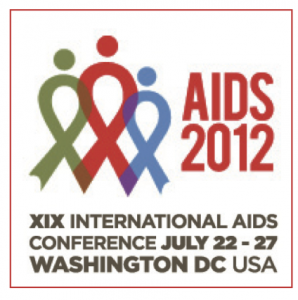Dolutegravir vs raltegravir in treatment-naive patients: 48 week results from the SPRING 2 study
1 August 2012. Related: Conference reports, Antiretrovirals, World AIDS 19 Washington 2012.
 Simon Collins, HIV i-Base
Simon Collins, HIV i-Base
Francois Raffi, from University of Nantes, France, presented the SPRING-2 study as an oral late breaker.
This was a randomised, double-blind, double-placebo controlled, non-inferiority study in treatment-naive patients. Participants (from Canada, US, Australia and Europe) were randomised (1:1; n=411 in each arm) to receive either 50 mg dolutegravir once-daily or 400 mg raltegravir twice-daily (plus matching placebo) with investigator selected tenofovir/FTC (60%) or abacavir/3TC (40%), stratified by baseline viral load (above and below 100,000 copies/mL) and by NRTI choice. The primary endpoint was viral suppression to <50 copies/mL with a lower margin confidence interval set at –10% to determine non-inferiority.
This was a largely white, male study population in patients with early-stage HIV. Approximate baseline characteristics for the study included median age of 36 years, 85% male, 85% white and 10% African American. Median viral load and CD4 count were approximately 35,000 copies/mL and 360 cells/mm3 respectively. No figures for the range or IQR were provided for the median values. However, 28% of patients had baseline viral load >100,000 copies/mL and 12% had a CD4 count <200 cells/mm3. Approximately 2% and 10% were coinfected with hepatitis B and C respectively.
Viral efficacy rates were 88% for dolutegravir and 85% for raltegravir, which, after adjusting for baseline viral load and NRTI, met the criteria for non-inferiority (difference 2.5%; 95% CI: -2.2% to 7.1%). Dolutegravir had a similarly rapid, or perhaps slightly faster, response compared to the already racy drop seen with raltegravir, with 70% of patients undetectable by week 4 and >80% by week 8.
Discontinuations were similar between the dolutegravir and raltegravir arms (11% vs 14%) and occured for similar reasons (4% vs 6% for lack of efficacy, 3% each for protocol violations, 2% each for side effects, and <1% vs 2% for each of loss to follow up and withdrawal of consent).
There were 7% of patients in each arm without 48-week data, with these discontinuations driven predominantly by reasons other than side effects.
Median CD4 counts increases were similarly close at weeks 8, 24 and 48: +88, +182 and +230 cells/mm3 in each arm.
Stratification by baseline viral load and nucleoside/tide use also met non-inferiority endpoints. Response rates were 90% vs 89% with <100,000 copies/mL (difference 0.4; 95%CI -4.5, 5.3) and 82% vs 75% (difference: 7.5; 95%CI -3.1, 18.0) with >100,000 copies/mL; and 86% vs 87% using abacavir/3TC (difference –0.8; 95%CI –8.2, 6.6) and 89% vs 85% using tenofovir/FTC (difference 4.6; 95%CI –1.3, 10.6) – all dolutegravir vs raltegravir, respectively.
There were slightly fewer patients with virological failure, defined as confirmed viral load >50 copies/mL at week 24 or after, in the dolutegravir arm (5% vs 7%; n=20 vs 28) with most (19/20) being between 50 and 400 copies/mL. Two patients in the raltegravir arm rebounded to 10-50,000 copies/mL and one to >100,000 copies/mL. One of these patients developed integrase inhibitor and NRTI mutations, with NRTI resistance only in three others. No mutations were detected in the dolutegravir arm.
Tolerability was good in both arms with low numbers of patients with grade 3 (n=2 vs 5) and grade 4 (n=2 vs 0) side effects. Serious adverse events occurred in 7% vs 8% (n=29 vs 31) but were only judged to be drug-related in 3 vs 5 patients. These included arrhythmia, hypersensitivity and hepatitis (dolutegravir) and convulsion (2), hypersensitivity/hepatitis, diarrhoea (raltegravir). Only 2% of patients in each arm discontinued due to side effects.
Grade 3/4 laboratory abnormalities were infrequent and included increases in creatinine phophokinase (5 vs 3%), AST (3 vs 2%) ALT (2 vs 2%) and lipase (2 vs 3%), all dolutegravir vs raltegravir. Slightly higher increases in mean creatinine (+12/3 vs +4.7 mmol/L; p=NS) and changes in creatinine clearance (–15.5 vs –5.4 mL/min; p=NS) occurred in the dolutegravir arm but dolutegravir does not affect eGFR and there were no discontinuations related to renal events in either arm.
comment
These results show similar levels of efficacy for both integrase inhibitors in treatment-naive easier to treat patients, with good tolerability.
Of note, both drugs also have paediatric formulations currently in development and/or clinical studies.
Reference:
Raffi F et al. Once-daily dolutegravir (DTG; S/GSK1349572) is non-inferior to raltegravir (RAL) in antiretroviral-naive adults: 48 week results from SPRING-2 (ING113086). 19th International AIDS Conference. 22-27 July 2012, Washington. Late breaker oral presentation THLBB04.
http://pag.aids2012.org/abstracts.aspx?aid=20990
http://pag.aids2012.org/flash.aspx?pid=3888

